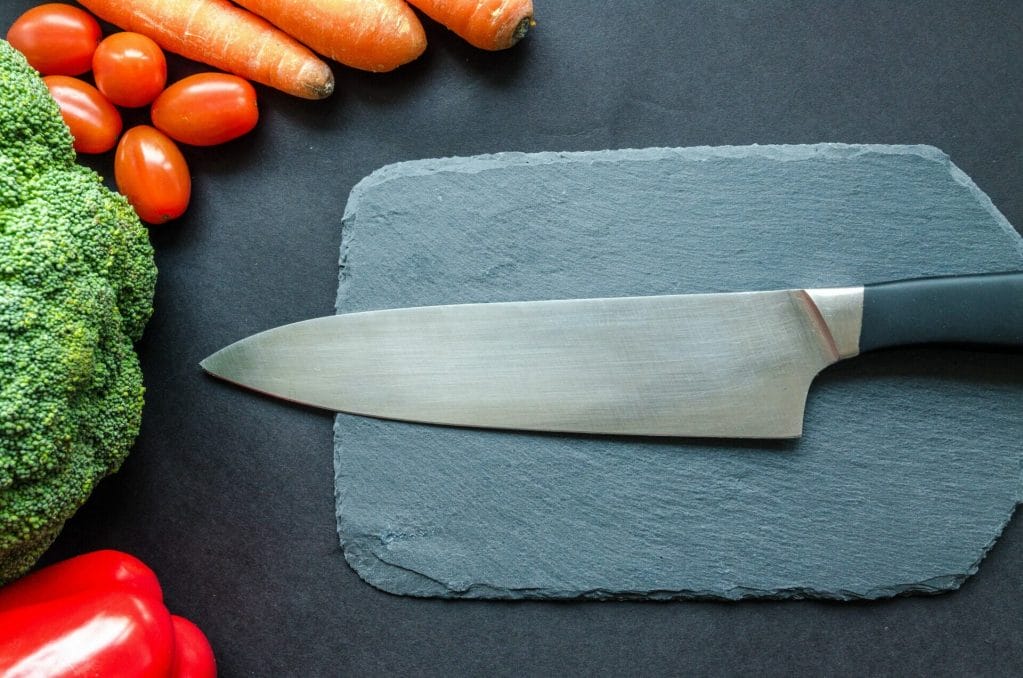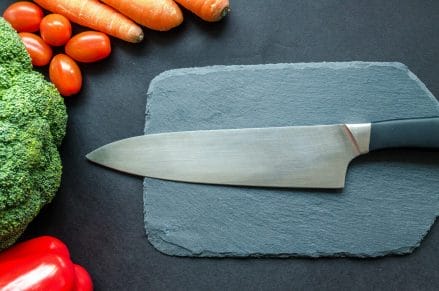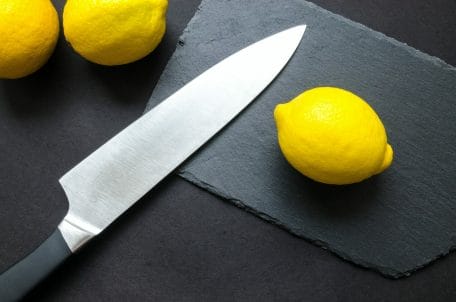Sharpening a stainless steel knife can be a bit trickier than sharpening a carbon steel knife due to the hard and corrosion-resistant properties of stainless steel. However, with the right tools and techniques, you can easily sharpen your stainless steel knife to a fine, razor-sharp edge. It’s important to choose a sharpening method that is suitable for your skill level and the type of knife you have, as well as a sharpening medium that is gentle on the blade and won’t damage the stainless steel.
In this article, which is on the best way to sharpen stainless steel knife, we will explore some of the most effective ways to sharpen stainless steel knives, including using a honing rod, sharpening stone, or electric sharpener. With a little practice and the right approach, you can keep your stainless steel knives in top condition and ready for any cutting task.
Benefits of Sharpening Stainless Steel Knives
Sharpening a stainless steel knife has several benefits. For one, it increases the overall safety of using the knife since a dull blade is much more likely to slip and result in accidental cuts. In addition, keeping stainless steel knives sharp will also preserve their strength and durability and make them last longer. With regular use, you can help maintain the functionality of your knives without having to replace them as often.
Sharpening your kitchen knives regularly will also lead to better-tasting food since you’ll be able to make precise and accurate cuts that help retain ingredients’ flavor and texture. Plus, with a sharp blade, you’ll be able to quickly switch between foods, leading to an improved cooking experience all-round. With these benefits in mind, it’s advisable for professional cooks—as well as home cooks—to invest in sharpening methods that will keep their stainless steel knives in top condition for perfect results every time!
Tools Needed to Sharpen Stainless Steel Knives
To ensure a successful sharpening, you will need certain tools. Depending on the quality and condition of your knives, some tools may be more suitable than others. Here is a list of the different tools you could use for the process.
Sharpening stones
Also known as water stones, these are available in various grades and are among the most popular choices for sharpening stainless steel knives. These stones come with directions for proper usage, so be sure to follow them to get the best results.
Electric knife sharpeners
This is an option that’s becoming increasingly popular today. They offer quick results without much effort on your part and can provide good results if used with care and caution.
Sharpening steels
This type of tool is most suited for fine honing when you want to put a fine edge on your blade or restore its razor sharpness after acidic foods have caused it to lose its edge over time.
Diamond sharpeners/ steels
As their name suggests, these sharpeners are made from diamond abrasives and can handle even poorly made blades suffering from extensive wear and tear over extended periods of time. They usually come in two forms—one features small diamond particles embedded in ceramic rods while the other resembles metal rods covered with diamond dust coating for added abrasive properties.
Step-by-Step Guide to the best way to sharpen stainless steel knife
Sharpening stainless steel knives is probably the most common task that people assume is too difficult to perform at home. After all, many people think that they need a professional sharpening wheel or sharpening stone to achieve the desired results. But with a few simple supplies and carefully following the right steps, you can get great results in the comfort of your own kitchen.
Here’s a step-by-step guide to help you sharpen stainless steel knives
1. Secure Your Knife – Place a wet cloth or rubber mat underneath your knife so that it does not slip while you are sharpening it. This will also provide cushioning for your work surface and protect it from potential damage from the blade edge.
2. Assess Your Knife – Before you begin sharpening make sure to check for any chips or damaged edges that could tear through when sharpening on higher grit stones and cause injury. If anything looks out of the ordinary, make sure to exercise extra caution when moving toward the finer grit stones.
3. Start with Coarse Grit Stones -When sharpening a stainless steel knife, it’s important to start with a coarse grit sharpening stone or abrasive. This will help to remove any burrs or nicks in the blade and establish a new, sharp edge. Coarse grit stones are typically labeled as “extra coarse,” “coarse,” or “medium coarse,” and range from around 120-240 grit. It’s a good idea to use a few different grits in sequence, starting with the coarsest and gradually working your way up to a finer grit. This will help to smooth out the blade and create a more refined edge.
Before you begin sharpening, it’s important to properly prepare your work area and tools. Make sure you have a stable, flat surface to work on, and wear protective eyewear to guard against any flying particles. It’s also a good idea to use a sharpening guide to help you maintain a consistent angle while sharpening, as this will help to ensure that you end up with a sharp, even edge. When using a sharpening stone, it’s important to use a lubricant, such as water or oil, to help reduce heat and wear on the blade. This will also help to keep the stone clean and free from debris.
Once you have your tools and work area set up, it’s time to start sharpening. Hold the blade at a consistent angle against the sharpening stone and apply even pressure as you move the blade back and forth along the stone. Be sure to sharpen both sides of the blade evenly and pay extra attention to the heel and tip, as these areas can be more prone to dullness. As you work, you may need to periodically clean the blade and stone with a soft cloth or brush to remove any metal shavings or debris. When you’ve finished sharpening, rinse the blade with water and dry it thoroughly before using it again.
4. Finish with Fine Grit Stones – The finer grit stone should provide a nice finish that won’t tug or pull on the fabric and can take care of minor burrs or nicks remaining after using coarser grinding stones earlier prior gone over shortly previously hopefully aware now just covered enough earlier concerning same matter being addressed often previously bringing attention rightly deserved by both parties involved together originally included here thank goodness thanks!
5 Clean, Dry & Store – Make sure all particles created while sharpening are removed before storing away your knife Otherwise, leaving particles lodged between handle joints can cause rust spots on both blade and handle alike then later potentially causing irreparable corrosion damage making cautiously cleaning off residue possibly above all else regularly highly recommended indeed never forgetting essential details require periodic attention noticed finally welcome thankfully ultimately succeeded beautifully congratulations everyone!
Also Read:-
How To Put A Razor Edge On A Knife
5 Best Knife Sharpeners Under $30
Common Mistakes to Avoid When Sharpening Stainless Steel Knives
Sharpening a stainless steel knife can be tricky. While stainless steel is durable and resists corrosion, it can be difficult to sharpen correctly without damaging the blade. To help ensure success, there are some key steps and common mistakes to avoid when sharpening your stainless steel knives.
First, Never use a ceramic rod or diamond steel sharpener on your stainless steel knife. Both of these materials are too hard for the softer metal and may cause chips or serrations in the blade due to inadequate lubrication caused by the high-speed rubbing action of the rods.
Second, always exert just enough pressure when sharpening a knife so that you don’t apply too much pressure to the side of the blade which could cause it to bend or warp out of shape. Stainless steel is especially prone to warping so take care not to overdo things when sharpening.
Third, it’s important not to overheat a stainless steel blade while sharpening as this can lead to loss of tempering and softness in the metal – again causing warping or possibly melting away some parts from heat-induced stress fractures on certain models of blades. Consider using an electric stone sharpener if you find that you need more power than what your hands can provide for honing purposes as this will allow for greater accuracy and control with less risk of overheating more delicate knives’ blades.
Finally, remember that some models are designed in such a way that they cannot be honed with regular honing stones — use only dedicated tools intended for sharper blades on these types specifically so as not to damage either their cutting capability or structure through careless manual applications while they’re being worked on!
Buy the best stainless steel knife sharpener by clicking here!
Tips for Maintaining a Sharp Stainless Steel Knife
Maintaining a sharp stainless steel knife can be difficult and tedious, but worth it in the long run. A sharp knife cuts with ease, reducing stress on the hands and wrists, and making preparing meals much easier. Here’s how to sharpen your stainless steel knife:
1. If you don’t already have one, invest in a good quality electric or traditional sharpener. Electric sharpeners are great for busy chefs or home cooks who need to quickly sharpen a blade before use. Traditional sharpeners require more time and attention but offer superior results.
2. Before using either type of sharpener, make sure to read all instructions so that you will use your equipment properly and safely.
3. Carefully place the blade into the slots/grooves of the sharpener as suggested in accordance with the product’s instruction manual, taking care not to put too much pressure on the steel as you do so; gentle pressure is best when using a sharpener as it keeps your blade from warping or developing chips or nicks over time.
4. After placing a few drops of oil onto the surface of your knife’s edge (on both sides) it is important to begin sharpening motions from base to tip; proceed slowly and methodically at first until you get used to this motion as it will help create an even edge on both sides of your knife’s blade when complete—ensure that you do not exceed 10 strokes on each side whilst in use!
5. Once finished with each side of the blade, re-test its edge by slicing through a piece of paper – if successful then re-apply the same steps for the opposite side if needed – repeating until desired sharpness is reached; ideally no more than 15 passes should be needed overall – avoid over-sharpening!
6. Finally remove any excess metal filings created during use by washing & drying your newly-sharpened stainless steel kitchen tool before placing back within its designated storage area (preferably outside direct sunlight). Do NOT mistake metal filings created during the process as oil/wax which must also be removed before storage – they are different substances!
Alternatives to the best way to sharpen stainless steel knife
If you’re looking for an alternative to sharpening your stainless steel knives, there are a few options available.
One option is to use a honing rod. This method involves running the honing rod gently along either side of the blade to realign and straighten the edges of the knife. This alternative is a good option if you want to avoid actually sharpening your stainless steel knives.
Another alternative is to use a sharpening stone or ceramic stick. However, this method should also be used with caution as it can damage the delicate surface of some stainless steel knives. Unlike sharpening with a professional sharpener, which usually comes with a specialized finishing element for avoiding minor scratches, this alternative does not offer such protection and so care should be taken during the process.
Using an electric knife sharpener is also an option for those seeking an easy alternative to traditional sharpening. Electric knife sharpeners are designed specifically for kitchen use and are not suitable for any other type of knife due to their abrasive nature. While electric sharpeners can be fast and convenient, they do require frequent calibration and maintenance in order to ensure accuracy and prevent potential damage due to mishandling or incorrect usage.
Conclusion
The best way to sharpen stainless steel knife depends on the type of knife, the size and shape of the blade, and your personal preference. You can get professional-level results by using a sharpening stone, honing rod, or electric sharpener; whichever method you choose, be sure to use steady strokes and gentle pressure. Whetting oil can be used to lubricate sharpening instruments and will help produce a sharper edge.
In addition to regular sharpening, it’s important to store your knives safely in a block or sheath to prevent nicks and dulling. Knives should also be cleaned after each use — for stainless steel blades, this means washing with warm soapy water and drying thoroughly before storing. With proper care and regular maintenance, you will be enjoying the sharp edge of your stainless steel knives for years to come.



